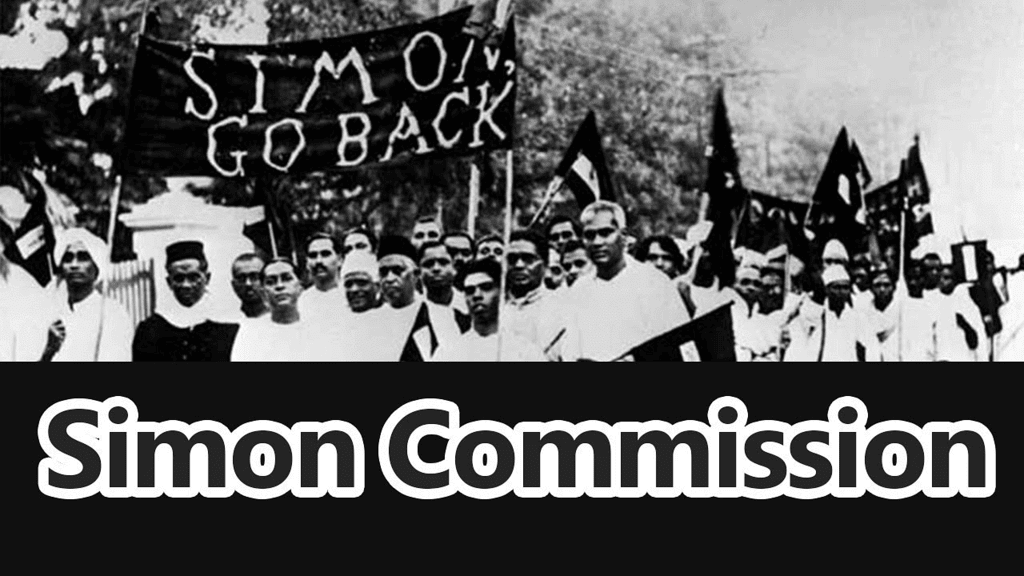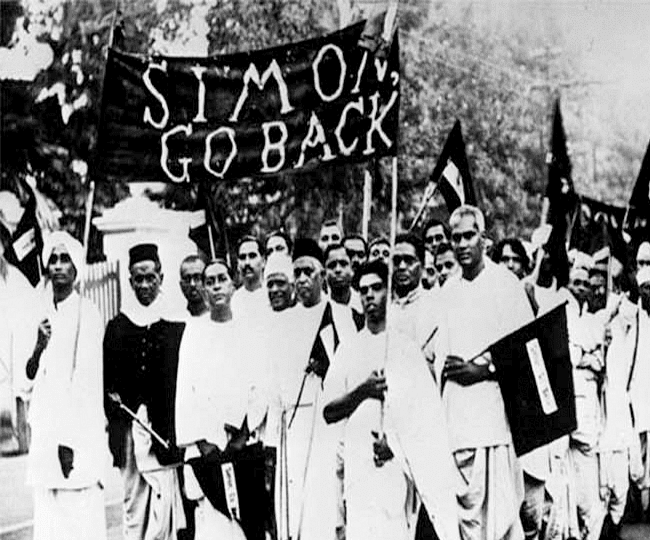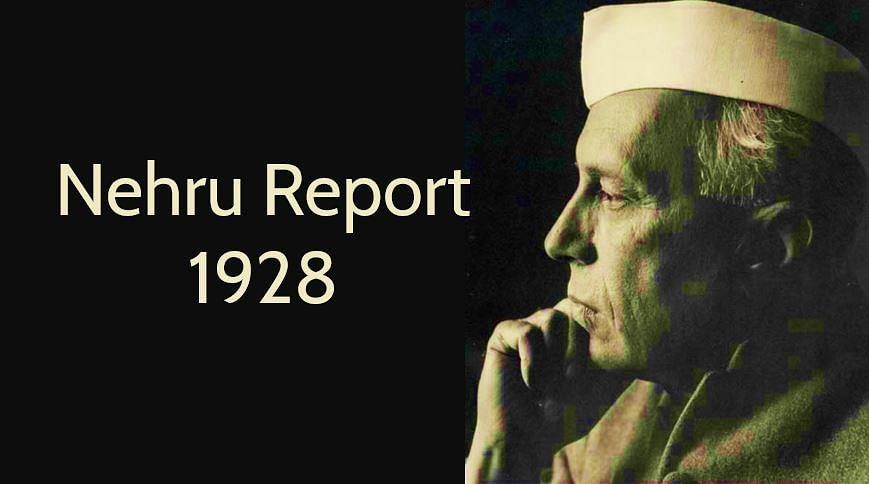Spectrum Summary: Simon Commission & the Nehru Report | History for UPSC CSE PDF Download
| Table of contents |

|
| Appointment of the Indian Statutory Commission |

|
| Indian Response |

|
| Nehru Report |

|
| The Muslim and Hindu Communal Responses |

|
| Jinnah’s Fourteen Points |

|
Appointment of the Indian Statutory Commission
The Simon Commission, formally known as the Indian Statutory Commission, was established in 1927 by the British government to assess the progress of governance in India. Named after its chairman, Sir John Simon, the seven-member commission drew attention for being exclusively composed of white individuals.

- Background of the Government of India Act, 1919:
- The Government of India Act in 1919 included a provision that set the stage for a commission to be appointed ten years later.
- This commission was intended to evaluate and gauge the progress of governance within India over the preceding decade.
- By incorporating this provision, the Act aimed to ensure a periodic and systematic review of the effectiveness of the governance structure, allowing for adjustments and reforms based on the commission's findings after ten years.
- Setting up the Simon Commission:
- In 1927, an all-white, seven-member commission called the Indian Statutory Commission was formed. It gained popular recognition as the Simon Commission, named after its chairman, Sir John Simon.
- The primary objective of this commission was to assess whether India was prepared for additional constitutional reforms and, if so, to provide recommendations on the specific directions these reforms should take.
- Early Commission Appointment (1927):
- During this time, the British political landscape saw the Conservative Party in power, and they were concerned about the possibility of losing the next election to the Labour Party. The term "prized colony" refers to India, which was a crucial and valuable part of the British Empire.
- The fear was that if the Labour Party came to power, they might handle the decision-making about India's constitutional future in a way that the Conservatives considered "irresponsible."
- The Conservatives, therefore, expedited the formation of the Simon Commission to ensure that this important and sensitive matter would be addressed under their governance, rather than potentially being influenced or mishandled by a political rival.
- Mid-1920s Parliamentary Reports and Inquiries:
- The Lee Commission looked into why there weren't enough British officers in India. The British officers were the ones in charge of various aspects of governance, and there was a concern that there weren't sufficient numbers. They wanted to figure out why this was happening and how to fix it.
- The Mudiman Commission was focused on understanding a problem within the diarchic system. Diarchy means having two authorities or power centers. In India, this was about the division of powers between Indian officials and British officials. The commission aimed to find out why there was a deadlock or a situation where decisions couldn't be easily made within this system
- Reasons for Simon Commission Appointment:
- The 1919 Act, designed to govern India, faced stability issues, prompting the British government to take a closer look. Lord Birkenhead, the Conservative Secretary of State for India, expressed doubts about the ability of Indians to formulate an effective plan for reform with broad political support.
- Seeing the shortcomings of the existing rules and fearing instability, the British government felt the need to thoroughly examine the workings of the 1919 Act.
- This assessment was driven by a desire to address the inadequacies and make improvements for more effective governance in India.
- Lord Birkenhead's Role:
- The person responsible for appointing the Simon Commission was Lord Birkenhead, who served as the Conservative Secretary of State for India.
- Lord Birkenhead held the belief that Indians were not capable of formulating a strong and comprehensive plan for constitutional reforms that would receive widespread support.
- In simpler terms, he thought that the people in India couldn't come up with a solid and widely accepted proposal for changing the fundamental rules of how the country was governed. Because of this belief, Lord Birkenhead took charge and appointed the Simon Commission himself.
Indian Response
Indians were very upset with the Simon Commission, and their reaction was quick and united. The main reason for their anger was that the commission didn't include any Indians and the idea that foreigners were going to talk about and decide if India was ready to govern itself. This made Indians feel like their right to decide their future, called self-determination, was being ignored.
(a) Congress Response:
 M.A. Ansari
M.A. Ansari
- In December 1927, during a Congress meeting in Madras led by M.A. Ansari, a significant decision was made regarding the Simon Commission. The attendees, including leaders like Jawaharlal Nehru, agreed to boycott the Simon Commission completely, at every step and in every possible way.
- This meant they would refuse to cooperate or engage with the commission in any form. Moreover, Nehru played a crucial role during this session by successfully proposing a resolution. This resolution declared that the ultimate or final aim of the Congress was complete independence for India.
(b) Other Groups:
- Those who chose to support the Congress in boycotting the Simon Commission included the liberal members of the Hindu Mahasabha and the larger faction of the Muslim League led by Jinnah. In 1927, the Muslim League had two separate sessions to discuss their stance on the Simon Commission.
- Under Jinnah's leadership in Calcutta, it was decided to oppose the commission. However, during another session in Lahore under Muhammad Shafi, there was support for the government.On the other hand, some groups decided not to join the boycott.
- The Unionists in Punjab and the Justice Party in the southern part of India were among those who opted not to boycott the Simon Commission.
(c) Public Response:

- When the Simon Commission arrived in Bombay on February 3, 1928, the public response in India was strong and widespread. On that day, a countrywide hartal (strike) was organized, accompanied by mass rallies.
- Wherever the commission went, there were demonstrations with black flags, strikes, and slogans demanding 'Simon Go Back.' This movement was notable for the active participation of a new generation of youth, marking their first involvement in political action. Leaders like Jawaharlal Nehru and Subhash Bose emerged as prominent figures during this wave of youth and student activism.
- They extensively traveled, addressed large gatherings, and presided over conferences, becoming influential voices in the protest against the Simon Commission. The surge of youth involvement also created a ground for new radical ideas. This led to the formation of groups such as the Punjab Naujawan Bharat Sabha, Workers' and Peasants' Parties, and Hindustani Sewa Dal in Karnataka, reflecting the changing and evolving political landscape.
(d) Police Repression:
- The police were very harsh towards the people protesting. They used lathis (batons) forcefully, not even sparing the senior leaders.
- In Lucknow, Jawaharlal Nehru and G.B. Pant were physically attacked. In October 1928, Lala Lajpat Rai suffered serious injuries to his chest during a protest, and these injuries were so severe that he passed away on November 17, 1928.
- The police actions during these protests were violent and had severe consequences, leading to injuries and even the death of prominent leaders.
Impact of Appointment of Simon Commission on the National Movement
(i) The announcement of the Simon Commission sparked a push for significant changes, not just in seeking full independence but also in demanding major social and economic reforms inspired by socialist ideas. For the Congress, which didn't have a specific plan in motion at that time, this became an important issue that brought people together for collective action.
(ii) When Lord Birkenhead challenged Indian politicians to come up with a united constitution, different political groups agreed to this challenge. This raised hopes for unity among Indians at that time. In simpler terms, it was an opportunity for Indian leaders to work together in creating a constitution that everyone could agree on.
The Simon Commission Recommendations
- Simon Commission's Recommendations (1930):
- Proposed ending dyarchy and establishing representative government in provinces. Recommended autonomy for provinces, with increased members in provincial legislative councils.
- Suggested the governor have discretionary powers for internal security and administrative matters to protect communities.
- Rejected parliamentary responsibility at the center, giving complete power to the governor-general to appoint cabinet members.
- Advocated Government of India's complete control over the high court.
- Electoral and Franchise Recommendations:
- Recommended retaining separate communal electorates (for Hindus and Muslims) until tensions eased.
- Rejected the idea of universal franchise; not everyone would have voting rights.
- Federalism and Consultative Council:
- Accepted the idea of federalism but suggested it for the future.
- Proposed the creation of a Consultative Council of Greater India, including representatives from British provinces and princely states.
- Provincial Representation and Separation:
- Suggested local legislatures for the North-West Frontier Province and Baluchistan, with representation at the center.
- Recommended the separation of Sindh from Bombay and Burma from India due to perceived natural disconnections.
- Indian Army and Relevance of Recommendations:
- Proposed Indianizing the army while retaining British forces until India was fully equipped.
- By the time the report was released, events had surpassed its importance, making its recommendations less relevant.
Nehru Report

- Challenge and Response: Lord Birkenhead challenged Indian politicians to create a constitution, prompting a response through the convening of the All Parties Conference in February 1928.
- Formation of Subcommittee:The All Parties Conference appointed a subcommittee, with Motilal Nehru leading the effort to draft a constitution. This marked a crucial step in India's political history, as it was a significant attempt by Indians to create a constitutional framework for the country.
- Committee Members: The committee consisted of influential members such as Tej Bahadur Sapru, Subhash Bose, M.S. Aney, Mangal Singh, Ali Imam, Shuab Qureshi, and G.R. Pradhan. These individuals represented various political perspectives and regions, contributing to a diverse range of opinions.
- Timeline and Finalization: The committee worked diligently on drafting the constitution and successfully finalized the report by August 1928. This swift timeline highlighted the urgency and commitment of the Indian leaders to address the constitutional issues.
- Recommendations: The recommendations put forth by the Nehru Committee were mostly unanimous, indicating a general consensus on the proposed constitutional framework. However, a notable point of disagreement centered around the choice between "dominion status" and "complete independence."
- Majority's Approach: Despite the difference in opinions on the basis of the constitution, the majority of the committee favored "dominion status." Importantly, the majority allowed the minority, advocating for "complete independence," the freedom to pursue their preferred goal, showcasing a spirit of accommodation within the committee.
Main Recommendations
1. Dominion Status: The Nehru Report recommended giving India a status akin to self-governing dominions, envisioning a future federal connection with princely states. However, this proposal stirred disagreements, particularly among the younger, more militant section, with figures like Nehru expressing discontent.
2. Rejection of Separate Electorates: A fundamental departure from existing constitutional reforms, the report proposed rejecting separate electorates. Instead, it advocated for joint electorates with reserved seats for Muslims, specifically in areas where they were a minority, excluding regions where they formed the majority, such as Punjab and Bengal.
3. Linguistic Provinces: The Nehru Report suggested the creation of provinces based on language, emphasizing a linguistic basis for administrative divisions.
4. Fundamental Rights: Outlining nineteen fundamental rights, the report covered aspects like equal rights for women, the right to form unions, and universal adult suffrage.
5. Responsible Government: The report stressed the need for responsible government both at the center and in provinces. It proposed a structured Indian Parliament with a 500-member House of Representatives and a 200-member Senate, each elected through different methods and serving varying tenures. The central government, led by a governor-general appointed by the British government but paid from Indian revenues, would act on the advice of the central executive council responsible to the Parliament. Provincial councils, each having a 5-year tenure, would be led by a governor following the advice of the provincial executive council.
6. Protection of Muslim Interests: The Nehru Report emphasized full protection of the cultural and religious interests of Muslims, ensuring their rights were safeguarded.
7. Separation of State and Religion: Highlighting a crucial principle, the report called for the complete separation of the state from religion, underscoring the need for a secular government.
The Muslim and Hindu Communal Responses
1. Communal Differences in Constitution Drafting: As political leaders enthusiastically began drafting a constitutional framework for India, communal differences arose, particularly concerning communal representation in the Nehru Report.
2. Delhi Proposals of Muslim League: In December 1927, Muslim leaders gathered in Delhi during the Muslim League session, formulating four proposals known as the 'Delhi Proposals.' These were:
(i) joint electorates in place of separate electorates with reserved seats for Muslims;
(ii) one-third representation to Muslims in the Central Legislative Assembly;
(iii) representation to Muslims in Punjab and Bengal in proportion to their population;
(iv) Formation of three new Muslim majority provinces— Sindh, Baluchistan, and North-West Frontier Province.
3. Hindu Mahasabha Demands: The Hindu Mahasabha strongly opposed the creation of new Muslim-majority provinces and reservations for Muslims in legislatures. They insisted on a strictly unitary structure, further complicating the situation.
4. Compromises: During the All Parties Conference discussions, the Muslim League maintained its demand for reserved seats for Muslims, especially in the central legislature and Muslim-majority provinces. This posed a dilemma for leaders like Motilal Nehru drafting the Nehru Report. To address the challenges, concessions were made, including :
(i) Joint electorates proposed everywhere but reservation for Muslims only wherein minority;
(ii) Sindh to be detached from Bombay only after dominion status was granted and subject to the weightage given to the Hindu minority in Sindh;
(iii) Political structure proposed broadly unitary, as residual powers rested with the center.
These compromises aimed to navigate the delicate balance between Hindu and Muslim communal interests.
Amendments Proposed by Jinnah
- At the All Parties Conference held at Calcutta in December 1928 to consider the Nehru Report, Jinnah, on behalf of the Muslim League, proposed three amendments to the report:
(i) One-third representation to Muslims in the central legislature;
(ii) Reserved seats for Muslims in Bengal and Punjab legislatures based on their population until everyone had the right to vote.
Unfortunately, these suggestions were not accepted.
Jinnah’s Fourteen Points
Later, in March 1929, Jinnah proposed fourteen points as the foundation for future Muslim League activities.
- A federal constitution with certain powers given to provinces.
- Independence for provinces in decision-making.
- No changes to the constitution without agreement from all states forming the Indian federation.
- Ensuring adequate representation for Muslims in legislatures in every province.
- Proper representation for Muslims in government services and self-governing bodies.
- One-third representation for Muslims in the central legislature.
- One-third representation for Muslims in any central or provincial cabinet.
- Keeping separate electorates.
- No law or decision to pass if three-fourths of a minority community disagrees.
- Protecting the Muslim majority in Punjab, Bengal, and NWFP during any territorial changes.
- Separating Sindh from Bombay.
- Constitutional changes in NWFP and Baluchistan.
- Full freedom of religion for all communities.
- Safeguarding Muslim rights in religion, culture, education, and language.

- Federal Constitution with residual powers to provinces.
- Provincial autonomy. No constitutional amendment by the center without the concurrence of the states constituting the Indian federation.
- All legislatures and elected bodies to have adequate representation of Muslims in every province without reducing a majority of Muslims in a province to a minority or equality.
- Adequate representation to Muslims in the services and in self-governing bodies.
- One-third of Muslim representation in the central legislature.
- In any cabinet at the center or in the provinces, one-third to be Muslims.
- Separate electorates.
- No bill or resolution in any legislature to be passed if three-fourths of a minority community consider such a bill or resolution to be against their interests.
- Any territorial redistribution not to affect the Muslim majority in Punjab, Bengal, and NWFP.
- Separation of Sindh from Bombay.
- Constitutional reforms in the NWFP and Baluchistan.
- Full religious freedom to all communities.
- Protection of Muslim rights in religion, culture, education, and language.
Nehru Report Found Unsatisfactory
Many groups were unhappy with the Nehru Report, not just the Muslim League, Hindu Mahasabha, and Sikh communalists, but also the younger members of the Congress, led by Jawaharlal Nehru and Subhash Bose. The younger section saw the proposal of dominion status in the report as a step backward. The All Parties Conference made them even more critical of this idea. In response, Nehru and Subhash Bose rejected the Congress' modified goal and together formed the Independence for India League.
|
112 videos|495 docs|173 tests
|
FAQs on Spectrum Summary: Simon Commission & the Nehru Report - History for UPSC CSE
| 1. What was the appointment of the Indian Statutory Commission? |  |
| 2. What was the Indian response to the appointment of the Indian Statutory Commission? |  |
| 3. What was the Nehru Report? |  |
| 4. What were Jinnah's Fourteen Points? |  |
| 5. How did the Muslim and Hindu communities respond to the Nehru Report? |  |

|
Explore Courses for UPSC exam
|

|


















